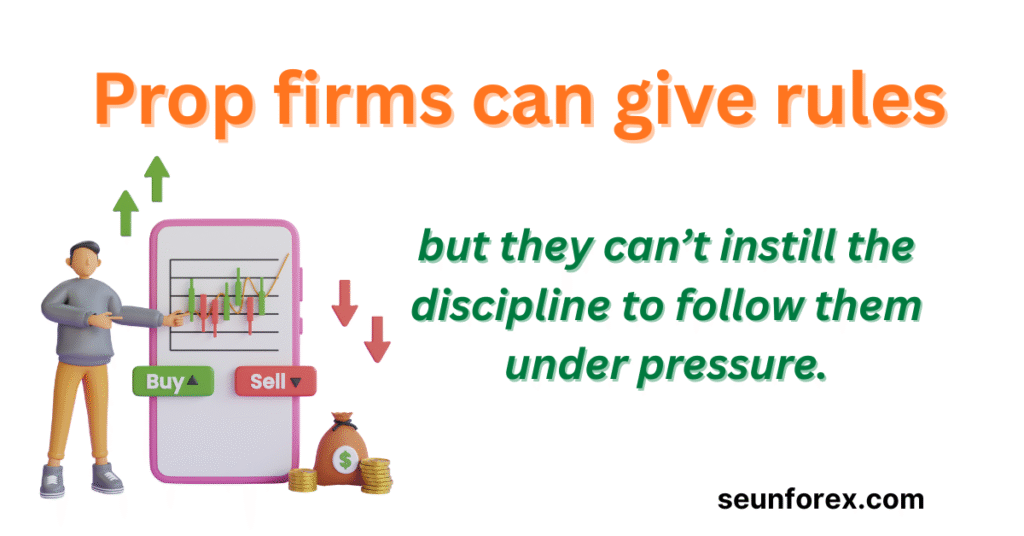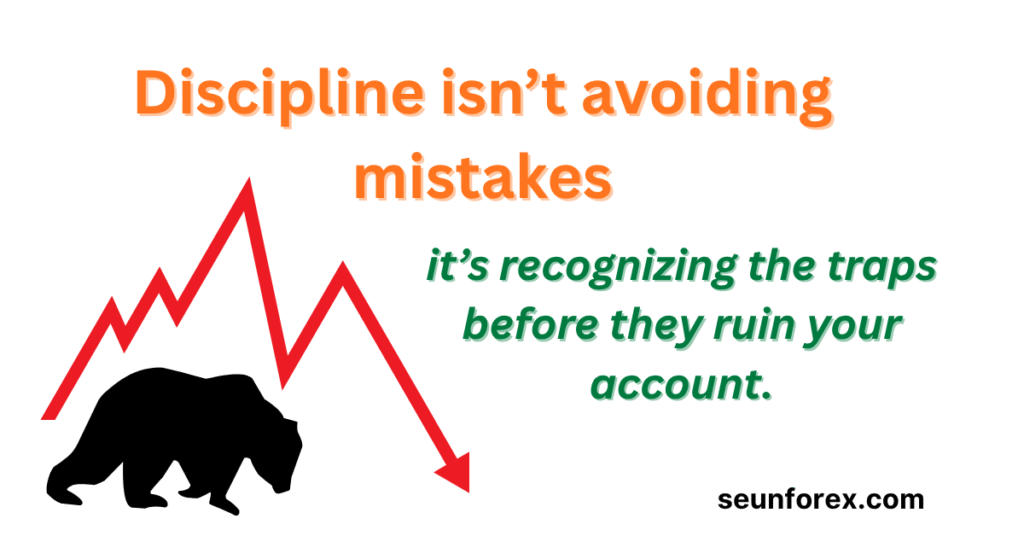
Introduction: Discipline Isn’t Just About Following Rules
Most retail traders think Trader Self-Discipline is simply “stick to your trading plan” or “don’t chase losses.” Prop firms love selling this narrative because it keeps traders busy but not truly profitable. True Trader Self-Discipline is deeper—it’s the invisible skill that determines whether your edge survives market chaos or erodes under emotional pressure.
Imagine Trader Self-Discipline as a muscle: prop firms know most traders never strengthen it, and without it, even the best strategies fail. This article will guide you step by step, revealing the hidden layer of discipline, why prop firms obscure it, and how to cultivate Trader Self-Discipline to dominate your trading.
Section 1: The Hidden Truth About Discipline in Prop Trading
1.1 Trader Self-Discipline vs. Compliance
Prop firms often equate Trader Self-Discipline with compliance: following their rules blindly.
True Trader Self-Discipline is internalized; it’s not just obeying risk limits or trade counts—it’s knowing why you’re taking each action and resisting the urge to deviate even when the market screams otherwise.
1.2 The Prop Firm Illusion
Prop firms profit when traders fail. Their rules enforce structure, but structure ≠ profitability.
For example, a trader may follow a daily drawdown rule, but panic-trades after small losses due to fear or ego still cause drawdowns. That’s a failure of Trader Self-Discipline, not compliance.
1.3 Trader Self-Discipline as Psychological Mastery
At its core, Trader Self-Discipline is emotional regulation and decision clarity under stress.
Studies of top hedge fund managers show that 70–80% of profitable trading comes from consistent execution, not strategy brilliance. Strong Trader Self-Discipline ensures that your strategy survives volatility and emotional pressure.
Section 2: The Anatomy of a Disciplined Trader
2.1 Mental Framework
- Discipline starts with a mindset, not a checklist.
- Key traits: patience, humility, consistency, and confidence built on preparation.
2.2 Routine and Process
- A disciplined trader creates habits around preparation, execution, and post-trade reflection.
- Example: Every morning, review open positions, set risk parameters, and visualize possible market moves.
2.3 Emotional Anchors
- Traders face stress triggers: news, volatility, peer pressure, and personal bias.
- Tools for anchoring discipline: journaling, pre-defined responses to triggers, and mini “decision audits” during the day.
Section 3: Why Prop Firms Don’t Teach True Discipline

3.1 The Business Model
- Prop firms profit when traders fail. If everyone learned discipline, fewer traders would blow accounts.
- Rules are often reactive, not educational: e.g., “no trading past 2 minutes after news” protects capital, but doesn’t build internal control.
3.2 The Myth of Strategy over Self-Mastery
- Many prop firm training programs prioritize strategies over self-mastery.
- Lesson: You can have the best risk/reward system, but without discipline, your execution will crumble during drawdowns.
3.3 The Silent Curriculum
- Observation: Most top traders develop discipline independently—through demo accounts, journaling, or trial-and-error.
- The hidden edge: those who focus on their own psychological rules outperform those who follow external rules blindly.
Section 4: Discipline Deep Dive – Step by Step
Inspired by the Wall Street Trader deep-dive approach:
4.1 Step 1: Track Every Emotional Reaction
- For 30 days, record every trade along with your emotional state before, during, and after execution.
- Look for patterns: Are losses triggering impulsive trades? Are profits causing overconfidence?
4.2 Step 2: Identify Discipline Breakpoints
- Review your journal: mark moments when you deviated from your plan.
- Categorize: fear-based, greed-based, impatience-based, or external-influence-based deviations.
4.3 Step 3: Create a Discipline Map
- Map each trigger to a tactical solution:
- Fear → pre-defined stop-loss
- Greed → profit-scaling rules
- Impatience → timer or mini-breaks
- Use a consistent template for every trade. Example:
| Trade Date | Setup | Emotional State | Deviation | Correction Rule | Outcome |
|---|---|---|---|---|---|
| 05/10/25 | EURUSD Breakout | Fear | Added extra lot | Fixed position sizing | +0.5R |
4.4 Step 4: Simulate Stress Conditions
- Use demo accounts or paper trades under conditions of time pressure, news, or market whipsaws.
- Observe whether your discipline map holds. Adjust accordingly.
4.5 Step 5: Forward-Test with Tiny Risk
- Only after internal mastery should you move to live accounts.
- Small risk trades test both strategy and discipline under real stress.
Section 5: Trading Plan Discipline vs. Mental Discipline
5.1 Trading Plan Discipline
- This is structural: stop-losses, position sizing, daily drawdowns.
- Prop firms monitor this. Compliance is easy to measure.
5.2 Mental Discipline
- Invisible and internalized: your ability to resist impulsive trades, avoid revenge trading, and stay calm under volatility.
- Hard to measure, but it’s the real determinant of long-term success.
5.3 Integrating Both
- The edge comes when you embed mental discipline into every structural rule.
- Example: Your daily drawdown limit isn’t just a rule—it becomes a psychological anchor preventing emotional escalation.
Section 6: Common Discipline Pitfalls and How to Avoid Them

6.1 Pitfall: Over-Optimizing Strategies
- Many traders obsess over backtests while neglecting execution discipline.
- Reality: A mediocre strategy executed perfectly often outperforms a perfect strategy executed poorly.
6.2 Pitfall: Trading to Prove a Point
- Ego-driven trades destroy discipline.
- Solution: Treat trading like a systemized experiment—no emotional attachment.
6.3 Pitfall: Ignoring Small Losses
- Small deviations compound. Missing stops, partial risk breaches, or incremental lot creep erodes discipline over months.
6.4 Pitfall: Neglecting Post-Trade Reflection
- Discipline isn’t just during trades—it’s after trades, reviewing and refining your mental and mechanical rules.
Section 7: Discipline as a Compound Edge
7.1 Compounding Emotional Capital
- Just like compounding money, disciplined execution compounds edge over months and years.
7.2 Example: Swing Trader Case Study
- Trader A: 0.5R loss occasionally due to impatience.
- Trader B: Always follows discipline map.
- Result over 12 months: Trader B outperforms Trader A by 2–3× equity growth despite identical strategies.
7.3 Quantifying Discipline
- Track % of trades executed exactly as planned.
- Goal: reach >95% consistency before scaling risk.
Section 8: Discipline Tools & Workflows
8.1 Journaling Templates
- Emotional state, plan deviation, and corrective action fields.
8.2 Timer & Break System
- Prevent decision fatigue; schedule micro-breaks to maintain clarity.
8.3 Stress Simulation Drills
- Demo account “shock tests” with unexpected moves or sudden volatility spikes.
8.4 Visual Anchors
- Chart overlays, entry triggers, and psychological reminders visible during trading sessions.
Section 9: Putting It All Together – Your Discipline Bootcamp
9.1 Phase 1: Awareness (1 Week)
- Track every trade and emotional state.
9.2 Phase 2: Correction Mapping (1 Week)
- Build discipline map and pre-defined responses.
9.3 Phase 3: Simulation (2–3 Weeks)
- Stress-test strategies under controlled risk.
9.4 Phase 4: Forward Testing (1–2 Months)
- Small live trades, strict adherence, journaling every deviation.
9.5 Phase 5: Refinement & Scaling
- Only scale risk when >95% trades are executed according to plan and mental discipline is automatic.
Section 10: Conclusion – Discipline as Your Secret Edge
Prop firms will give you rules, structure, and account limits—but they will never teach you the hidden skill of internalized discipline. The market doesn’t care about compliance—it rewards execution under uncertainty.
- Discipline compounds like capital.
- Emotional mastery ensures strategy survives volatility.
- Your edge is built in the unseen 80% of trading: the mental, not the mechanical.
If you want to outperform 90% of traders and keep your prop firm account alive long-term, focus relentlessly on Trader Self-Discipline as a skill, not a rule.
For practical methods to strengthen your discipline, check out our trading journal techniques that help you track mistakes, reflect, and reinforce good habits.
For additional authoritative guidance, Investopedia’s “20 Rules Followed by Professional Traders” highlights the importance of internalizing discipline and consistently applying your trading plan.
“The difference between a trader who survives and one who thrives isn’t strategy—it’s whether discipline is a muscle or a suggestion.”